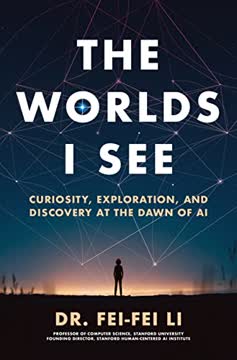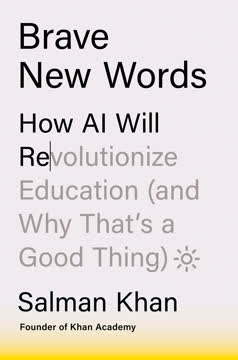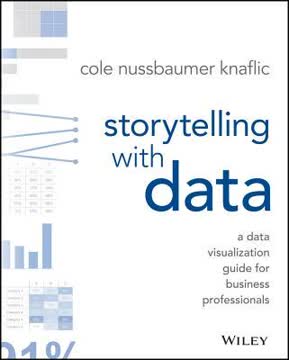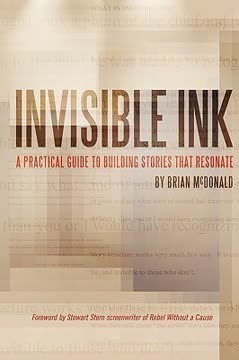Puntos clave
1. Tinta Invisible: Los Elementos Ocultos de la Narración
La tinta invisible es la escritura que se encuentra debajo de la superficie de las palabras. La mayoría de las personas nunca la verán o notarán, pero la sentirán.
El poder de la sutileza. La tinta invisible se refiere a la estructura subyacente y las técnicas que hacen que una historia sea atractiva sin ser abiertamente notoria. Es la base que sostiene los elementos visibles de una historia, como el diálogo y la acción.
Impacto en la audiencia. Aunque los lectores o espectadores no reconozcan conscientemente estos elementos ocultos, impactan significativamente en su compromiso emocional y comprensión de la historia. Dominar la tinta invisible permite a los narradores crear obras que resuenen profundamente con su audiencia.
Ejemplos de tinta invisible:
- Arcos de personajes
- Desarrollo de temas
- Presagios
- Subtexto en el diálogo
- Imágenes simbólicas
2. La Armadura: Construyendo la Base de Tu Historia
Tu armadura es la base que sostiene tu historia. Todo se cuelga sobre ella. Cada decisión que tomes debe basarse en la idea de dramatizar tu idea de armadura.
Definiendo la armadura. La armadura es el tema central o mensaje de tu historia. Es la idea principal que deseas transmitir a tu audiencia, sirviendo como la columna vertebral de tu narrativa.
Implementando la armadura. Cada elemento de tu historia debe apoyar y reforzar este tema central. Los personajes, los puntos de la trama y el diálogo deben trabajar juntos para iluminar tu armadura.
Ejemplos de armaduras efectivas:
- "El amor lo conquista todo" en Romeo y Julieta
- "El poder absoluto corrompe absolutamente" en Rebelión en la Granja
- "La importancia de la familia" en El Padrino
3. Dolor Ritual: Transformando Personajes a Través del Conflicto
Aplica suficiente presión y calor para convertir un trozo de carbón en un diamante.
La necesidad del conflicto. Los personajes deben enfrentar desafíos significativos y dolor para crecer y cambiar. Este "dolor ritual" es esencial para el desarrollo significativo de los personajes y una narración atractiva.
Tipos de dolor ritual:
- Desafíos físicos
- Turmoil emocional
- Dilemas morales
- Pérdida y sacrificio
Impacto en el arco del personaje. Al superar estos obstáculos, los personajes demuestran crecimiento y transformación, haciendo su viaje más atractivo y relatable para la audiencia.
4. Decir la Verdad: El Poder de la Autenticidad en la Ficción
La verdad siempre será más triste, más feliz, más divertida, más aterradora y más profunda que la mejor mentira.
Resonancia emocional. La narración auténtica, incluso en entornos ficticios, crea una conexión emocional más fuerte con la audiencia. Aprovecha las experiencias y emociones humanas universales.
Evitando clichés y estereotipos. La verdad en la narración significa ir más allá de los tropos predecibles y explorar las complejidades de la naturaleza humana y las situaciones del mundo real.
Ejemplos de narración veraz:
- Motivaciones de personajes matizadas
- Consecuencias realistas para las acciones
- Retrato honesto de relaciones y conflictos
5. Equilibrando Elementos Masculinos y Femeninos en la Narración
Las cosas que afectan físicamente a un personaje son masculinas y son tinta visible. Cómo se siente al respecto es femenino e invisible.
Definiendo elementos masculinos y femeninos:
- Masculino: Acciones externas, eventos impulsados por la trama
- Femenino: Emociones internas, desarrollo del personaje
Creando equilibrio. Una historia bien elaborada combina elementos masculinos y femeninos para crear una narrativa rica y multidimensional que atrae a una amplia audiencia.
Impacto en la narración:
- Involucrar tanto la lógica como la emoción
- Crear personajes bien redondeados
- Atraer a diversas preferencias de audiencia
6. Posición Superior: Involucrando a la Audiencia a Través del Conocimiento
La posición superior es cuando la audiencia sabe algo que los personajes no saben.
Creando tensión. La posición superior permite a la audiencia anticipar eventos, creando suspense e inversión emocional en la historia.
Tipos de posición superior:
- Ironía dramática
- Presagios
- Narrativas de múltiples perspectivas
Mejorando el compromiso de la audiencia. Al dar a la audiencia información que los personajes no tienen, los narradores pueden crear un sentido de participación y anticipación que mantiene a los espectadores o lectores interesados en la narrativa.
7. Diálogo: Más Que Solo Palabras en una Página
El diálogo es una herramienta, y al igual que cualquier herramienta, la usas cuando la necesitas. Puede usarse para definir tu armadura, dar información esencial de la trama o revelar el carácter. Si no está haciendo eso, no está haciendo nada.
Propósito del diálogo. El diálogo efectivo cumple múltiples funciones en la narración, más allá de simplemente transmitir información entre personajes.
Funciones clave del diálogo:
- Revelar rasgos y motivaciones de los personajes
- Avanzar en la trama
- Reforzar el tema de la historia
- Crear subtexto y tensión
Diálogo natural vs. estilizado. Aunque el diálogo debe sonar natural, también debe ser más intencionado y conciso que una conversación en la vida real, siempre sirviendo a las necesidades de la historia.
8. El Mito del Género: Trascendiendo Categorías para una Mejor Narración
El género es irrelevante para el dramaturgo. Un dramaturgo solo debe preocuparse por el drama.
Limitaciones del género. Centrarse demasiado en las convenciones de género puede restringir la creatividad y llevar a una narración formulaica.
Principios universales de narración. Las grandes historias a menudo trascienden las fronteras de género al centrarse en temas universales y arcos de personajes atractivos.
Adaptación a través de géneros:
- Reimaginar historias clásicas en nuevos entornos
- Combinar elementos de múltiples géneros
- Centrarse en el personaje y el tema sobre los tropos de género
9. Clímax: La Culminación del Crecimiento del Personaje
Un clímax es la unión de los elementos masculinos y femeninos que muestra el cambio del personaje, o la falta de él.
Propósito del clímax. El clímax sirve como la prueba definitiva del crecimiento y transformación de un personaje a lo largo de la historia.
Elementos de un clímax efectivo:
- Situación de alto riesgo
- Decisión crucial del personaje
- Demostración de cambio (o fracaso en cambiar)
- Resolución de conflictos internos y externos
Impacto en la audiencia. Un clímax bien elaborado proporciona catarsis emocional y una conclusión satisfactoria al viaje del personaje.
10. Creando Tramas de Apoyo para Reforzar Tu Mensaje Principal
Todo debe colgar de la misma armadura.
Propósito de las tramas de apoyo. En lugar de ser "subtramas" separadas, las tramas de apoyo deben reforzar e iluminar directamente el tema y mensaje central de la historia principal.
Integrando tramas de apoyo:
- Arcos de personajes paralelos que reflejan el viaje del protagonista
- Exploración de diferentes facetas del tema principal
- Proporcionar perspectivas contrastantes o complementarias
Evitando distracciones. Las tramas de apoyo deben mejorar la narrativa principal, no distraer de ella o sentirse desconectadas de la historia central.
Última actualización:
FAQ
What's "Invisible Ink: A Practical Guide to Building Stories That Resonate" about?
- Story Structure Focus: The book delves into the concept of "invisible ink," which refers to the underlying structure and elements of storytelling that aren't immediately visible but are crucial for a story's success.
- Author's Expertise: Written by Brian McDonald, an award-winning screenwriter, the book offers insights from his experience teaching story seminars at major studios like Pixar and Disney.
- Practical Guide: It provides practical tools and techniques for writers to create compelling stories and for readers to understand the art of storytelling.
- Examples and Analysis: The book uses examples from popular movies and scripts to illustrate its points, making it accessible and relatable.
Why should I read "Invisible Ink" by Brian McDonald?
- Enhance Storytelling Skills: Whether you're a writer or a reader, the book offers valuable insights into the essential elements of storytelling that can improve your understanding and craft.
- Unique Perspective: It introduces the concept of "invisible ink," focusing on the unseen elements that make stories resonate with audiences.
- Expert Advice: Learn from Brian McDonald's extensive experience in the industry, including his work with major studios and his award-winning projects.
- Practical Application: The book provides actionable techniques and exercises that can be directly applied to your writing projects.
What are the key takeaways of "Invisible Ink"?
- Invisible Ink Concept: Understanding the importance of the underlying structure in storytelling, which is often more impactful than the visible elements like dialogue.
- Story Structure: The book emphasizes the significance of a well-structured story, using the "seven easy steps" framework to guide narrative development.
- Character Development: It highlights the importance of creating characters that undergo meaningful change, often through "ritual pain" or personal challenges.
- Theme and Armature: The book stresses the need for a strong theme or "armature" that supports the entire story, ensuring all elements contribute to the central message.
What are the "seven easy steps" to a better story according to Brian McDonald?
- Once upon a time: Establish the setting and introduce the main characters, setting the stage for the story.
- And every day: Show the normal world and routine of the characters, creating a baseline for the narrative.
- Until one day: Introduce the inciting incident that disrupts the normal world and propels the story forward.
- And because of this: Detail the consequences and reactions to the inciting incident, driving the plot.
- Until finally: Lead to the climax where the main conflict reaches its peak and is resolved.
- And ever since that day: Provide a denouement that shows the new normal and the impact of the story's events.
How does Brian McDonald define "Invisible Ink"?
- Below the Surface: "Invisible ink" refers to the elements of storytelling that are not immediately visible but are crucial for the story's success.
- Story Structure: It includes the order of events, character motivations, and thematic elements that support the narrative.
- Impact on Audience: These elements are felt by the audience, even if they are not consciously noticed, making the story resonate more deeply.
- Foundation of Storytelling: Invisible ink is the foundation upon which the visible elements, like dialogue and action, are built.
What is the "armature" in storytelling according to "Invisible Ink"?
- Core Idea: The armature is the central idea or theme that the story is built around, similar to the moral of a fable.
- Structural Integrity: It acts as the skeleton of the story, providing structural integrity and ensuring all elements support the central message.
- Guiding Principle: The armature guides the storyteller's decisions, helping to maintain focus and coherence throughout the narrative.
- Dramatization: The book emphasizes the importance of dramatizing the armature, making it an integral part of the story rather than an overt message.
What role does "ritual pain" play in character development in "Invisible Ink"?
- Transformation Tool: Ritual pain is a narrative device used to transform characters, often through significant challenges or personal hells.
- Character Growth: It forces characters to confront their flaws and undergo meaningful change, making them more relatable and compelling.
- Story Impact: The pain and struggle experienced by characters enhance the story's emotional depth and resonance with the audience.
- Universal Element: Ritual pain is a common element in storytelling across cultures, symbolizing the journey from one state of being to another.
How does "Invisible Ink" address the balance between masculine and feminine elements in storytelling?
- Masculine Elements: These are external, plot-driven aspects of a story, such as action and events that move the narrative forward.
- Feminine Elements: These are internal, character-driven aspects, focusing on emotions, relationships, and personal growth.
- Balance for Resonance: The book argues that a balance between these elements creates a more truthful and resonant story.
- Universal Appeal: By incorporating both elements, storytellers can appeal to a broader audience and create more impactful narratives.
What are some of the best quotes from "Invisible Ink" and what do they mean?
- "There is no art which does not conceal a still greater art." This quote emphasizes the importance of the unseen elements in storytelling that contribute to its overall impact.
- "A wise man speaks because he has something to say; a fool because he has to say something." It highlights the importance of having a clear purpose or message in storytelling.
- "Everybody wants to go to heaven, but nobody wants to die." This reflects the resistance to change and the necessity of ritual pain for character growth.
- "Don't give me logic, give me emotion." It underscores the importance of emotional truth over factual accuracy in storytelling.
How does Brian McDonald suggest using "superior position" in storytelling?
- Audience Knowledge: Superior position involves giving the audience information that the characters do not have, creating suspense or humor.
- Engagement Tool: It engages the audience by making them active participants in the story, as they anticipate the characters' reactions.
- Suspense Creation: This technique is often used to build suspense, as the audience knows something significant is about to happen.
- Humor and Irony: It can also be used for comedic effect, as the audience is in on a joke that the characters are unaware of.
What are some common mistakes in storytelling that "Invisible Ink" highlights?
- Ignoring Structure: Overlooking the importance of a well-structured story can lead to a lack of coherence and impact.
- Lack of Theme: Failing to establish a strong armature or theme can result in a story that feels aimless or shallow.
- Character Stagnation: Characters that do not undergo meaningful change or face ritual pain can seem flat and unengaging.
- Overemphasis on Dialogue: Focusing too much on dialogue without considering the underlying story elements can weaken the narrative.
How can "Invisible Ink" help improve your storytelling skills?
- Understanding Structure: The book provides a clear framework for constructing well-structured stories that resonate with audiences.
- Character Development: It offers insights into creating compelling characters that undergo meaningful change through ritual pain.
- Theme Integration: Learn to integrate a strong theme or armature into your story, ensuring all elements support the central message.
- Practical Techniques: The book includes practical exercises and examples that can be directly applied to your writing projects.
Reseñas
Tinta Invisible recibe en su mayoría críticas positivas, elogiada por sus ideas sobre la estructura y el tema de la narración. Los lectores la encuentran concisa, práctica y aplicable a diversos medios. Muchos aprecian el enfoque de McDonald en elementos "invisibles" como la armadura y el desarrollo de personajes. Los críticos señalan su simplicidad y la falta de profundidad en ciertos temas. El contenido relacionado con el género en un capítulo es controvertido. En general, se considera un recurso valioso tanto para escritores novatos como experimentados, ofreciendo una perspectiva fresca sobre la creación de narrativas atractivas.
Similar Books














